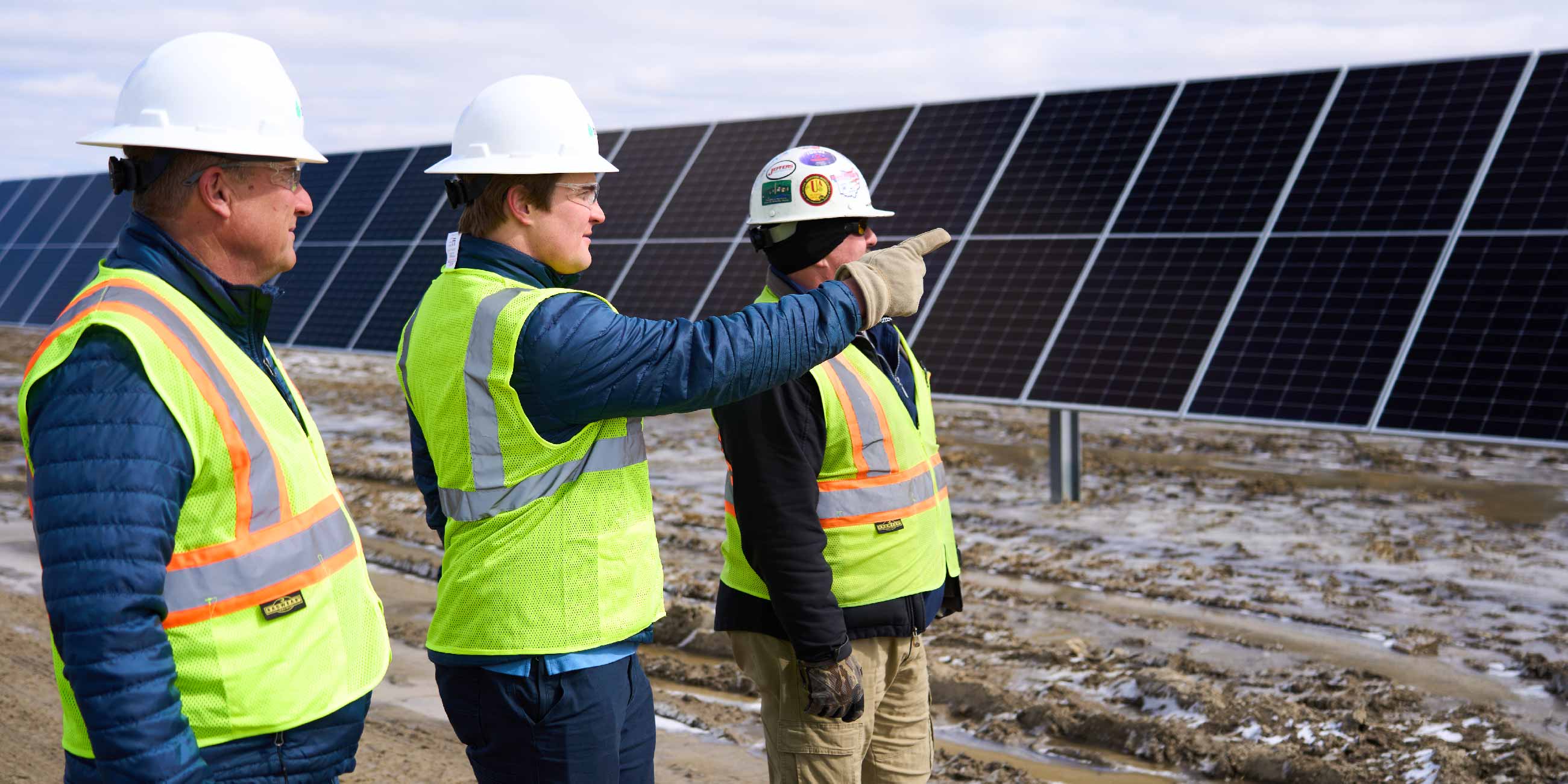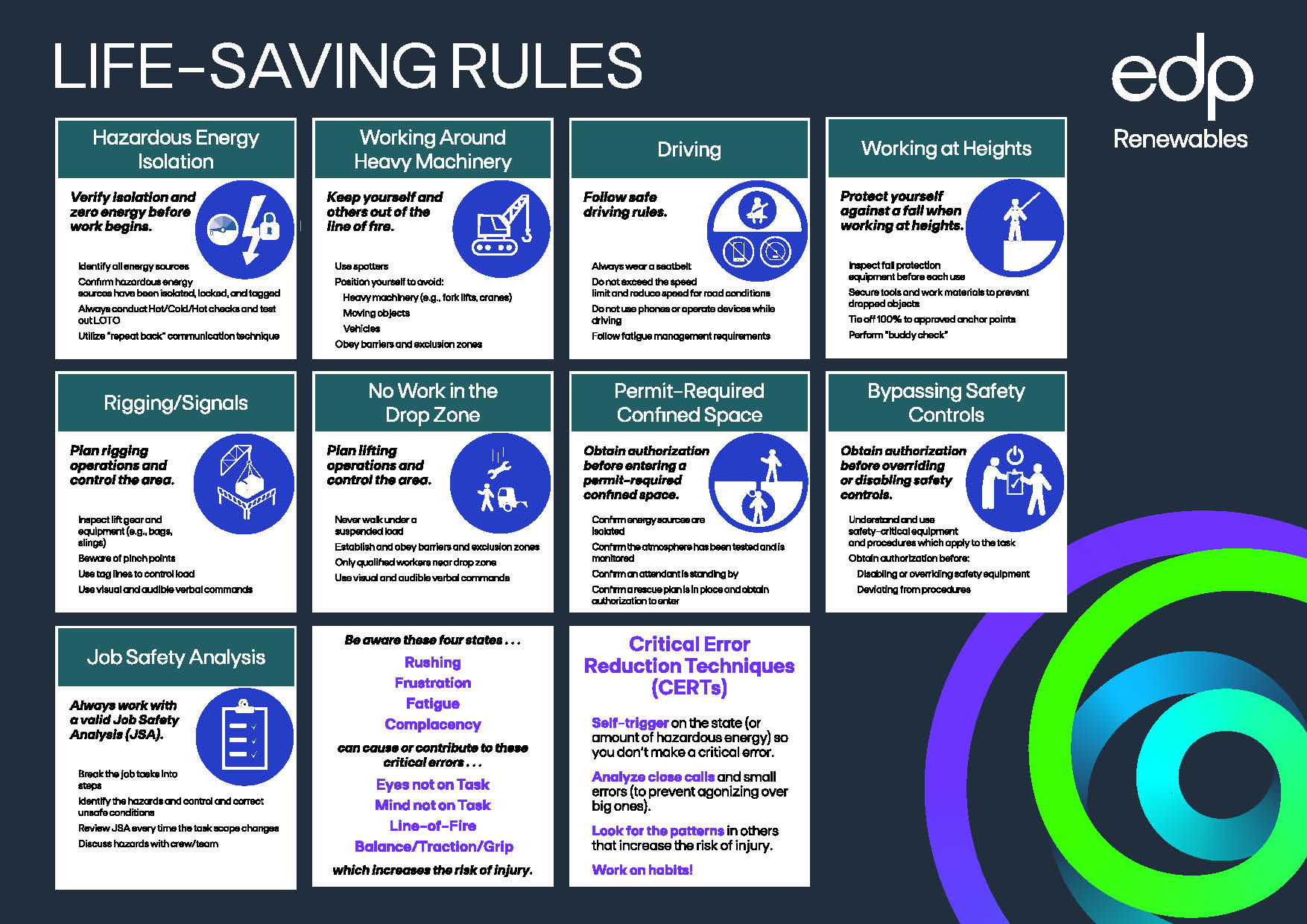
The Importance of Ensuring Safety at EDPR NA Distributed Generation

Author: Nidgel D’Souza, EHS, Solar & Project Management Associate
Distributed generation provides an impact-filled renewable energy solution located at the point of consumption and is a crucial part of the overall energy transition strategy. By generating sufficient electricity closer to end-users, EDPR NA DG can dramatically increase energy efficiency, reduce carbon pollution, improve grid resiliency, and repurpose the need for new transmission investments elsewhere. Solar innovation within the distributed generation sector has allowed EDPR NA DG to penetrate several markets that include municipalities, commercial businesses, and private landowners. There are a multitude of factors that have enabled EDPR NA DG to successfully own and operate 220 MWdc. One key factor to this success is safety.
Health & Safety Procedures:
There is a reason why “Safety First!” is an expression echoed across the construction industry. David Wolfert Jr., Director of Engineering and Safety at EDPR NA DG, has preached this quote to me since my first day at the company:
“If the workers turning the wrenches aren’t being safe, nothing else matters!”
There is considerable meaning in that one sentence. My takeaway is that if proper protocols are not in place to prioritize the health and well-being of the workers on site, then the productivity and quality of work will diminish significantly. To further simplify, without workers physically able and safely building our solar sites, we have nothing.
EDPR NA DG’s safety program exists to serve as a standard for each and every project we NTP (Notice to Proceed - essentially the green light to start construction). There are multiple layers to our safety program which include:
Weekly Safety Topics:
Weekly Safety Topics are relevant to current conditions and recent near misses that have happened on-site. This Safety Topic is brought up at the beginning of each contractor meeting as well as the weekly companywide meeting.
9 Life-Saving Rules:
These rules were established as the core principles for EDPR NA DG’s safety program and also relate to the top incidents that occur on a solar construction site. Below you’ll find a graphic outlining each of the 9 Life Saving Rules and how they are implemented.

3 Phase Inspections for each site under construction:
1) Safety Plan Review inspection, which reviews an EPC’s site safety manual before granting NTP to construct
This inspection analyzes a contractor’s safety plan before they mobilize to site.We review a number of items to ensure they meet our standards. We specifically look at the following: System Type, Vehicle Inspections, Severe Weather Plans, Required PPE, Lock Out & Tag Out (LOTO), Material Handling, Incident Reporting, and Site Safety Controls.
2) Internal Site Inspection for scheduled and unscheduled visits from construction and project managers
The adage, “Trust, but Verify” reflects our health and safety program’s granularity. We trust our contractors with enforcing their EDPR NA DG-approved safety plan and reporting data as required, but verification is needed from the developers (EDPR NA DG) end. In other words, seeing is believing when our construction and project managers visit our sites. Unscheduled visits speak volumes. The contractor should be consistent with their safety protocols day in and day out.
3) Weekly Safety Report from contractors indicating good catches, near misses, OSHA recordables, and other safety-related data points
Accountability is the influence for this report. Each week, our contractors share their safety statistics with us for recordkeeping purposes so that we can understand which contractors are executing approved safety standards over time.
Quarterly Health & Safety Reporting for sites in Operation:
At the end of each quarter, our Health & Safety team receives a report from each of our O&M partners which includes Man Hours, Number of workers on site, Good Catches, Near Misses, OSHA Recordables, and other metrics that allow us to analyze the effectiveness of safe practices. Some codes that we reference when completing designs:
- IFC 2018 (and 2021)
- NFPA 1, 15, 72, 68, 69, 855 (2020 and 2023), and more
- IEEE 1547
- UN 38.3 (Transportation)
- UL Standards: 1642, 1973, 1741, 9540, 9540A, and more
- NEC 690, Article 705IBC 2021: 1505, 1507, 1607, and more
Why This Matters:
Trust is a pillar of any relationship. Relying on trust in Health & Safety is critical.
The success of EDPR NA DG’s projects depends on a rigid safety program. Our collaborations with industry-leading safety leaders (NFPA, OSHA, UL, and more) have supported us in creating standards for building solar plus storage. At the end of the day, human life is at the center of this entire industry. From our daily logs to our Job Hazard Analysis (JHA) to our quarterly assessments of contractors, EDPR NA DG leaves no stone unturned when it comes to the safety of our sites.
Business competition for developing megawatts and gigawatts of power has been crucial in growing the distributed energy sector. However, there is no place for competition when it comes to the health and safety of the people turning the wrenches. Health & Safety should be pursued multilaterally across the renewables industry.
EDPR NA DG sells energy products and services, but if you look deeper, you will also see that we sell trust, too. This is trust in knowing that the solar + storage projects we construct today are building a cleaner future. This is trust in knowing that all our employees and contractors return home each day safe and sound. This is trust in knowing that EDPR NA DG pursues what is right for the planet today, tomorrow, and in the future.
This article shares various tracking and reporting processes EDPR NA DG’s Health & Safety team uses across all our operational and construction sites. Below you will find the contact info for EDPR NA DG’s Director of Engineering & Safety, David Wolfert, Jr., as well as my contact information. Please contact us with any thoughts you may have on how the industry can continue to optimize Health & Safety standards.
Contact Information:
Nidgel D’Souza,
EHS, Solar & Project Management Associate
nidgel.d’souza@edp.com,
Connect on LinkedIn
David Wolfert, Jr.,
Associate Director of Engineering & Safety
david.wolfertjr@edp.com,
Connect on LinkedIn
Sources: